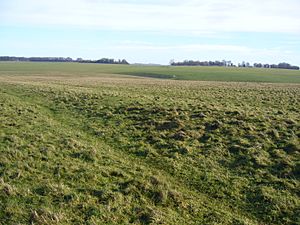Stonehenge Avenue facts for kids

The Avenue at Stonehenge looking ENE towards Old and New King Barrows
|
|
|
The Avenue, shown within the Stonehenge section of the Stonehenge and Avebury World Heritage Site
|
|
| Region | Wiltshire |
|---|---|
| Coordinates | 51°10′44″N 1°49′31″W / 51.179°N 1.8253°W |
| Type | avenue |
| History | |
| Periods | Neolithic |
| Site notes | |
| Excavation dates | from 1740, 2013 |
| Archaeologists | William Stukeley, Heather Sebire |
| Condition | Excellent |
| Public access | Yes |
| Website | National Trust |
| Type | Cultural |
| Criteria | i, ii, iii |
| Designated | 1986 (10th session) |
| Reference no. | 373 |
| Region | Europe and North America |
| Designated | 1882 |
| Reference no. | 1010140 |
The Stonehenge Avenue is an ancient path located on Salisbury Plain in Wiltshire, England. It is a very important part of the Stonehenge, Avebury and Associated Sites UNESCO World Heritage Site. This amazing ancient road was discovered in the 1700s.
It stretches for almost 3 kilometers (about 1.8 miles). The Avenue connects the famous stone circle of Stonehenge to the River Avon. Experts believe it was built a very long time ago, between 2600 and 1700 BCE. This was during a time known as the Stonehenge 3 period.
Contents
What is the Stonehenge Avenue?
The Stonehenge Avenue is like a special ancient road. It was built by people living in the Neolithic period. This period was also known as the New Stone Age. The Avenue is made up of two parallel ditches with banks on either side.
It was likely used for important ceremonies. People would have walked along it to reach Stonehenge. Imagine how many people walked this path thousands of years ago!
Why was the Avenue important?
One of the most interesting things about the Avenue is its alignment. For some of its length, it lines up perfectly with the sunrise on the summer solstice. The summer solstice is the longest day of the year. This suggests that the Avenue was used most often during this special time. It might have been part of ancient rituals.
Discoveries along the Avenue
In 2013, a section of the A344 road was closed. This road used to cut right through the Avenue near Stonehenge. When the road surface was removed, archaeologists made an exciting discovery. They found that even though the banks of the Avenue had been cut away, the filled-in ditches were still there. This proved that the Avenue continued all the way to the stone circle of Stonehenge.
At the very end of the Avenue, near the River Avon, another discovery was made in 2009. Archaeologists found a ring of pits. This site is now called Bluestonehenge. No large stones were found standing there. Some stone chips were found, but they were not related to the bluestones at Stonehenge.
Natural features and theories
Underneath the Avenue, there are natural grooves in the ground. These grooves were formed during the ice age. A researcher named Mike Parker Pearson has a theory about these grooves. He believes that the ancient people were inspired by these natural lines. He thinks they built the Avenue right on top of these natural formations. He also thinks these natural grooves already had an alignment with the sky.
Protecting the Stonehenge Avenue
The Stonehenge Avenue is a very important historical site. Because of its importance, it is protected by law. It is a Scheduled Monument, just like Stonehenge itself. This protection was first put in place in 1882. The 1882 act was one of the first laws in Britain to protect ancient archaeological sites. This means the Avenue is carefully looked after for future generations.


